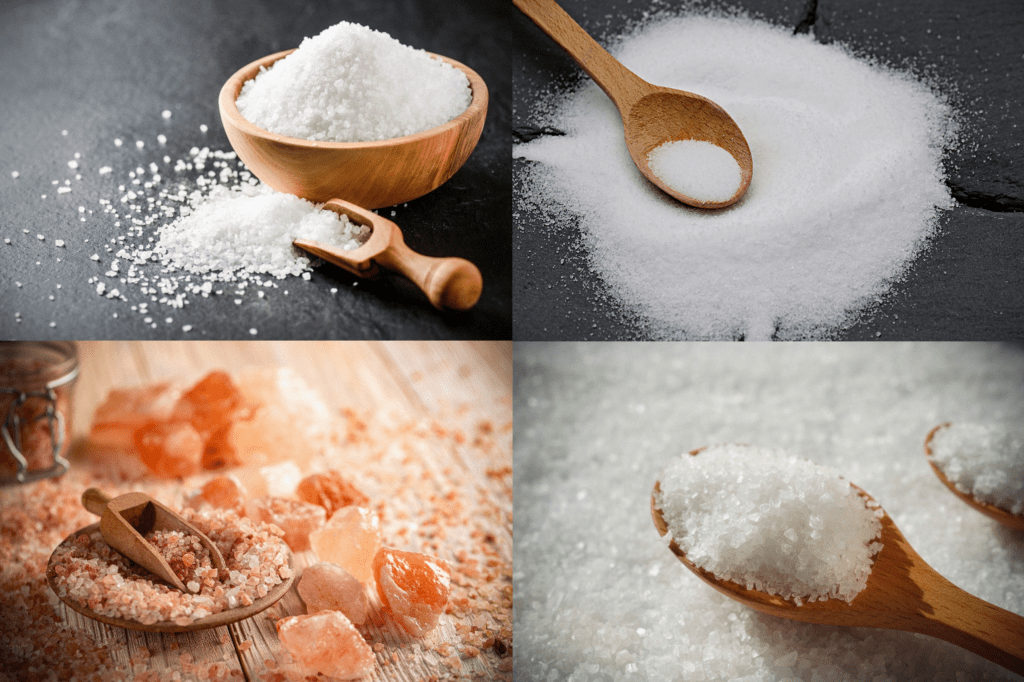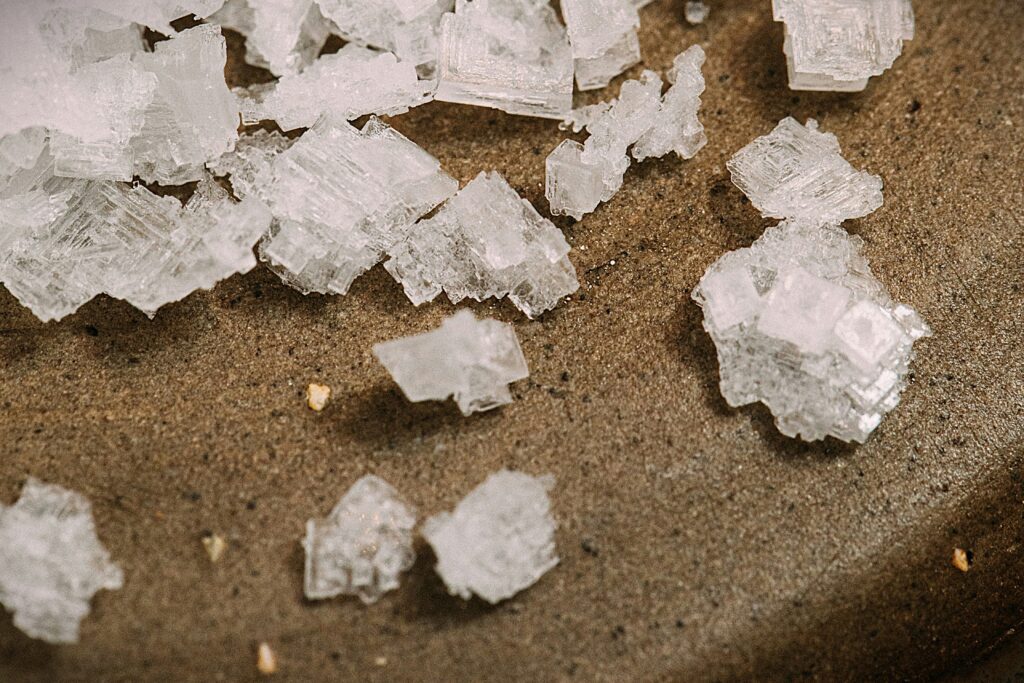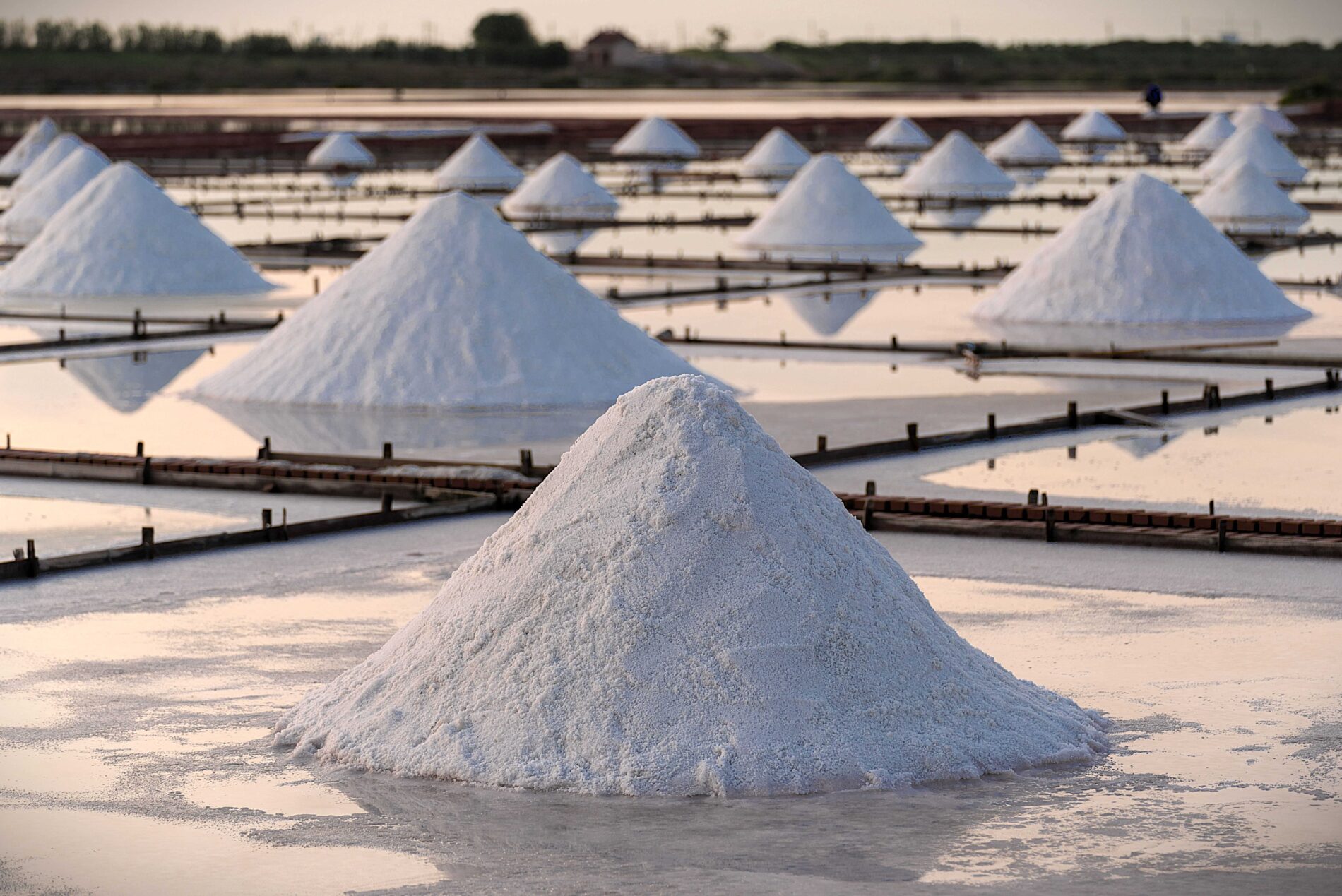Salt plays a fundamental role in food and beverage preparation, enhancing flavour and preserving ingredients. In its most common form salt is a crystalline compound that occurs naturally in various environments. This mineral has been harvested and used for millennia, shaping culinary traditions and economic trade.
Known chemically as sodium chloride (NaCl), salt is a naturally occurring mineral essential in human life. Found in seawater, underground deposits, and evaporated lakes, it has played a crucial role in food preservation and seasoning for centuries.
Different types of salt vary in texture, mineral content, and culinary applications. Sea salt comes from evaporated seawater, retaining trace minerals that influence its flavour. Rock salt, mined from underground deposits, is coarser and often used for de-icing and industrial purposes. Table salt, the most refined form, usually contains anti-caking agents and iodine to prevent deficiency. Himalayan salt, mined from ancient deposits in Pakistan, carries a distinctive pink hue due to trace iron content. Kosher salt, with its larger flakes, dissolves more slowly, making it a favourite for chefs.

What is the Salt Grading System?
Salt quality varies significantly depending on its source, processing method, and intended application. Grading systems ensure that salt meets specific standards, particularly in food manufacturing. Generally, salt falls into three primary grades: industrial, food-grade, and pharmaceutical.
- Industrial Grade: Often used in chemical manufacturing, water treatment, and de-icing, this salt may contain higher levels of impurities.
- Food-Grade: Meets strict purity and safety standards, making it suitable for consumption. It typically contains a minimum of 97% sodium chloride.
- Pharmaceutical Grade: Exceeds food-grade purity, with impurity levels controlled to meet the stringent requirements of medical and laboratory applications.
Within food-grade salt, subcategories such as table salt, kosher salt, and sea salt further distinguish grain size and processing methods. Refined salt undergoes purification to remove trace minerals, while unrefined varieties retain natural elements.
What are the Quality Control Measures for Salt in Food Manufacturing?
Food manufacturers follow rigorous protocols to ensure salt consistency and safety. Inspection begins at the source, where raw salt is tested for contaminants before processing. During refinement, producers monitor factors such as grain size, moisture content, and mineral composition.
Standard quality control measures include:
- Microbial Testing: Though salt inhibits bacterial growth, manufacturers still check for potential contaminants.
- Moisture Analysis: Excess water affects flow properties, leading to clumping. Consistent moisture levels ensure even dispersion in food products.
- Purity Verification: High-performance liquid chromatography (HPLC) and atomic absorption spectrometry assess sodium chloride concentration and detect impurities.
- Fortification Consistency: Iodised salt undergoes checks to verify iodine levels meet regulatory standards.
Salt Purity and its Impact on Food Processing
The chemical purity of salt affects its behaviour in food formulations. High sodium chloride concentration ensures predictable dissolution rates, which matter for baking, canning, and seasoning applications. Impurities, such as magnesium and calcium compounds, can alter texture, moisture retention, and even shelf stability.
For processed foods, consistency matters. Variability in salt composition influences flavour uniformity and preservation capabilities. In applications such as cheese production, mineral content affects protein interactions, influencing texture and ripening. Bakeries require finely milled salt to ensure even mixing and dough development.
Manufacturers rely on standardised salt specifications to maintain product integrity. Whether in snack seasoning or meat curing, controlled and grain size ensure precision in formulation, preventing unwanted changes in taste, texture, and preservation efficiency.
A popular salt, due to its purity, that is used in food manufacturing is PDV Salt…

What is PDV Salt?
Pure Dried Vacuum (PDV) salt undergoes an extensive refining process that removes impurities and yields a high-quality sodium chloride product. Unlike traditional sea or rock salt, PDV salt features a uniform granule size, exceptional whiteness and solubility. The properties make it a preferred choice for large-scale food production, where consistency and purity directly impact product quality.
Modifying Taste Naturally: Salt as Flavour Enhancer
Salt interacts with taste receptors by amplifying certain flavours and suppressing others. Sodium ions reduce bitterness by inhibiting bitter compounds while enhancing the perception of sweetness and umami. This effect occurs because salt modulates ion channels on the tongue, altering neural signals that influence taste perception.
The presence of sodium also increases salivation, which helps dissolve and distribute flavour compounds more efficiently. Greater dissolution leads to better flavour perception and a more balanced tasting experience. This mechanism explains why even small amounts of salt can enhance the overall taste of food.
Balancing Flavours Using Different Types of Salt
Salt’s grain size and mineral composition affect its ability to season foods. Fine-grain table salt dissolves quickly, providing immediate impact, while coarser options such as kosher and sea salt disperse flavours more gradually. Choosing the right type ensures optimal distribution and intensity.
- Table Salt: Highly refined with added iodine, it dissolves rapidly and provides a uniform seasoning effect.
- Kosher Salt: Larger crystals allow for controlled seasoning, making it ideal for curing meats and finishing dishes.
- Sea Salt: Contains trace minerals that contribute to complex flavour profiles depending on its origin.
- Flake Salt: Light, crisp texture enhances final flavour without overwhelming subtler ingredients.
Using a blend of salts in different stages of cooking enhances depth. For example, incorporating finer salt early ensures thorough integration, while flake salt applied at the end adds a burst of flavour and crunch.
Salts Interaction with Other Food Ingredients
Salt affects the behaviour of proteins, fats, and carbohydrates. In proteins, it influences structure by altering protein solubility and enhancing water retention. This improves the texture of cured meats and brined poultry. In dairy products, salt controls microbial activity in cheese ageing, shaping flavour development over time.
In baking, salt impacts gluten formation by tightening protein bonds in dough. This adjustment leads to improved texture and controlled yeast fermentation, preventing overexpansion. Meanwhile, in fat-heavy foods like butter and cheese, it enhances the perception of richness by reducing bitterness and elevating creamy textures.
The synergy between salt and acids, such as vinegar or citrus juice, further refines the sensory experience. Acid brightens flavours, while salt tempers harshness, creating a balanced and well-rounded taste profile. This interplay is evident in dishes like ceviche, where salt and lime work together to highlight the natural sweetness of fish.

What are Salt’s Functional Uses?
How Salt Impacts Texture in Processed Foods
Salt alters the texture of processed foods by modifying protein interactions and water retention. In baked goods, it regulates gluten formulation, affecting dough elasticity and final crumb structure. Reduced-salt formulations often require textural compensations, as salt enhances dough strength and gas retention.
In snack foods, salt influences crispness through its hygroscopic nature, modifying moisture migration. It also stabilises emulsions in processed dairy and dressings, preventing phase separation. This structural impact explains why salt adjustments require careful reformulation in industrial food production.
The Role of Salt in Protein Binding and Structure
Salt affects protein functionality by altering ionic interactions, which influence solubility, water-holding capacity, and gelation. In meat processing, it extracts myofibrillar proteins, essential for binding and forming stable emulsions in products like sausages and deli meats.
Protein solubility increases in salt solutions due to electrostatic effects. The mechanism enhances texture in processed fish, improving cohesion and moisture retention. In dough systems, salt modifies interactions between gluten proteins, influencing elasticity and extensibility.
Salt as a Carrier for Micro-Nutrients and Other Functional Additives
Salt serves not just as a seasoning but also as an efficient carrier for health-enhancing nutrients. Iodised salt remains a primary strategy to prevent iodine deficiency worldwide, ensuring adequate thyroid function across populations. Beyond iodine, researchers incorporate iron, folic acid and even probiotics into salt to address broader nutritional deficiencies.
Microencapsulation techniques stabilise these nutrients, preventing degradation during storage and cooking. This enables fortification strategies that maintain bioavailability while minimising impact on taste and texture. Additionally, salt’s widespread use ensures distribution of micronutrients across a wide range of diets and cuisines, effectively reaching diverse consumer groups.
Advancements in Salt for Functional Foods
Food scientists continue to explore new possibilities for salt in functional foods. Encapsulation techniques improve salt’s delivery, allowing for controlled release in processed products. Fine-tuned crystallisation processes adjust particle size and surface area, optimising its interaction with other ingredients. Additionally, modified salt structures enhance solubility and distribution in formulations that require uniform seasoning.
Blending salt with novel compounds creates multifunctional ingredients that extend shelf life, improve texture, and assist in other functional roles. In bakery applications, specially treated salt varieties regulate fermentation and yeast activity more precisely than traditional options. These innovations cater to evolving consumer preferences and the technical demands of modern food production.
Reduced-Sodium Solutions in Product Innovation
To meet sodium reduction targets while preserving flavour, food developers experiment with alternative sodium formulations. Potassium chloride, frequently blended with regular salt, replaces part of the sodium content without compromising taste. Other approaches involve leveraging seaweed extracts, amino acids such as L-arginine, which can help stimulate the release of the growth hormone, insulin, alongside other substances in the body, or a flavour enhancer that can mimic salty sensations.
Layered seasoning techniques introduce salt at multiple stages of processing, increasing perceived saltiness at lower concentrations. Surface application of fine-grain salt enhances immediate taste perception, reducing the need for higher amounts throughout the product. These innovations enable manufacturers to maintain consumer satisfaction while aligning with public health recommendations for sodium intake.
Daily Sodium Intake Recommendations
| Sodium | |
|---|---|
| <1 year old | No more than 1g |
| 1-3 years | No more than 2g |
| 4-6 years | No more than 3g |
| 7-10 years | No more than 5g |
| >10 years | No more than 6g |
The Role of Salt in Sports Nutrition
Salt isn’t just a dietary staple; it’s a key ingredient in many sports nutrition products. Whether it’s enhancing hydration, improving endurance, or aiding recovery, sodium is carefully incorporated into various formulations to support athletic performance.
Electrolyte Drinks and Hydration Mixes
One of the most common applications of salt in sports nutrition is in electrolyte drinks and powders. These products contain sodium alongside other electrolytes, such as potassium and magnesium, to:
- Replenish lost minerals during sweating.
- Improve fluid retention for better hydration.
- Maintain proper nerve and muscle function.
Electrolyte beverages often contain carefully measured sodium levels to ensure optimal absorption without causing excessive thirst or bloating.
Sports Gels and Energy Chews
Endurance athletes rely on sports gels and chews to sustain energy levels during long event. These products often contain a mix or carbohydrates and sodium to:
- Replace electrolytes lost through sweat.
- Support faster carbohydrate absorption.
- Help prevent muscle cramps and fatigue.
Sodium enhances glucose uptake, ensuring that energy is delivered efficiently to working muscles.
Protein and Recovery Drinks
Post-workout recovery formulas often include sodium to assist with fluid balance and nutrient absorption. When paired with protein and carbohydrates, sodium helps to:
- Speed up muscle glycogen replenishment.
- Improve rehydration after intense exercise.
- Reduce post-workout muscle soreness.
Salt Capsules for Endurance Athletes
For athletes training in extreme heat or participating in ultra-endurance events, salt capsules or tablets are used to prevent hyponatremia (dangerously low sodium levels). These capsules provide a controlled dose of sodium to:
- Maintain electrolyte balance over extended periods.
- Prevent dehydration and subsequent dizziness and fatigue.
- Reduce the risk of heat-related illnesses.
Sports Snacks
While many sports nutrition products focus on sweet flavours, some endurance athletes prefer salty snacks for variety and better sodium replenishment. Ingredients like salted nuts, pretzels, and savoury protein bars provide:
- A natural source of sodium for electrolyte balance.
- A more appealing alternative for those who experience “sweet fatigue” from energy gels and drinks.
- Steady energy release and balance macros.

The Link Between Salt, Blood Pressure and Health
Sodium helps regulate fluid balance and nerve function, but too much can raise blood pressure. Cutting back on sodium can help lower blood pressure, especially in people with hypertension.
Elevated blood pressure increases the risk of cardiovascular diseases, including stroke and heart attack. The World Health Organisation (WHO) estimates that excessive sodium intake contributes to 1.89 million deaths annually from cardiovascular diseases worldwide (WHO). Most dietary sodium comes from processed and restaurant foods, not from table salt sprinkled on meals.
Strategies for Reducing Sodium in Processed Foods
Food manufacturers have adopted multiple approaches to lower sodium levels without compromising taste or product stability. These strategies include:
- Gradual Sodium Reduction: Reducing sodium in small increments over time allows consumers to adjust to lower salt levels without noticing a sudden taste change.
- Salt Replacers: Potassium chloride and calcium chloride mimic the taste and function of sodium chloride while reducing overall sodium content.
- Flavour Enhancement Techniques: Process adjustments, such as altering grain size and distribution, enhance saltiness perception an reduce total sodium use.
- Texture Modification: Process adjustments, such as altering grain size and distribution, enhance saltiness perception and reduce total sodium use.
- Encapsulation Technology: New formulations control sea salt release during consumption, optimising flavour impact while lowering sodium concentration.
Ethical Sourcing: Procurement of Salt
Supply Chain Dynamic of Salt Sourcing
Salt moves through a structured supply chain that begins with extraction and ends with distribution. The three primary methods of extraction (solar evaporation, mining, and vacuum evaporation) affect both sourcing logistics and environmental impact. Each step, from raw material extraction to refined product delivery, involves multiple stakeholders, including miners, refiners, transport operators, and distributors.
Geography determines sourcing efficiency. Large-scale salt-processing nations like China, the United States, and India influence pricing and availability. Companies assess transportation costs, labour conditions, and trade regulations before selecting suppliers. Ethical concerns arise when supply chains include regions with poor labour rights or environmentally damaging extraction practices.
Environmental and Economic Considerations in Salt Production
Salt extraction methods impact ecosystems and local economies differently. Solar evaporation, which relies on natural evaporation of seawater, has the lowest energy demands but requires vast coastal land and long processing times. Rock salt mining digs into underground deposits, disrupting local geology and potentially contaminating groundwater. Vacuum evaporation, a high-energy method, produces purified salt but increases carbon emissions.
Economically, the salt industry supports millions of workers worldwide, from small-scale salt farmers to Ghana to industrial producers in Australia. However, price volatility affects both producers and consumers. Natural disasters, geopolitical events, and climate change can disrupt supply chains and lead to price fluctuations.
Building Sustainable Partnerships for Salt Procurement
Long-term sustainability in salt sourcing depends on responsible supply chain management. Companies partner with suppliers to ensure ethical labour practices and minimal environmental harm. Certifications such as Fair Trade and Rainforest Alliance compliance indicate responsible sourcing, even in the salt industry.
Some businesses invest directly in sustainable salt farming initiatives. For example, solar salt farms in India use minimal intervention methods, allowing natural evaporation while supporting local communities with fair wages. Transparent procurement practices, third-party audits, and direct cooperation with local producers help maintain ethical integrity in salt sourcing.
- Supply chain transparency ensures accountability form sourcing to retail.
- Eco-friendly production minimises deforestation, soil degradation, and water pollution.
- Fair labour practices protect workers from exploitative condition.
- Direct trade agreements support small producers in developing markets.
Frequently Asked Questions (FAQs)
What exactly is salt, and how is it different from sodium?
Salt is a mineral composed mainly of sodium and chloride (NaCl). While “salt” and “sodium” are often used interchangeably, sodium is just one part of salt. Our bodies need small amounts of sodium for muscle function and fluid balance, but too much can lead to health issues like high blood pressure.
Why is salt used in food manufacturing?
Salt plays several key roles in food production. It enhances flavour, preserves shelf life, supports texture, and can help with food safety by limiting microbial growth. In baked goods, for example, it also helps control yeast activity.
What does salt PDV mean?
PDV stands for “Pure Dried Vacuum” salt. It’s a high purity form of refined salt made using a vacuum drying process. PDV salt is free-flowing, white, and consistent in crystal size, making it ideal for food manufacturing where uniformity is essential.
How is PDV salt different from table salt?
While both are forms of sodium chloride, PDV salt is more refined and produced specifically for industrial and food production purposes. Table salt may include additives like anti-caking agents or iodine for home use, while PDV salt is usually additive-free and very pure.
Are there different types of salt used in food production?
Yes. Besides PDV salt, food manufacturers might use sea salt, rock salt, or kosher salt – each offering different textures, purity levels, and functional properties. The choice depends on the application and desired characteristics of the final product.
Is salt always added just for taste?
No. although flavour enhancement is a major reason, salt also plays functional roles in fermentation, food safety, texture, and preservation. For example, in canned foods or ready meals, salt helps extend shelf life and maintain stability.
How does salt affect texture and structure of food?
In products like bread or meat, salt strengthens protein structure, impact water retention, and helps maintain the desired texture. In cheese and cured meats, salt also helps develop structure over time during processing.
Is salt safe to consume in large amounts?
Salt is essential in small amounts, but excessive intake can be harmful. Most health authorities recommend limiting sodium to about 2,300mg mg per day (around 6g of salt), though many people exceed this through processed foods. Food producers are increasingly working on reformulations to reduce salt content while maintaining quality.
What’s the role of salt in nutrition and health?
Salt helps regulate fluid balance, supports nerve function, and aids muscle contraction. However, consistently high intake may raise the risk of high blood pressure and cardiovascular disease. That why balanced use in both home cooking and food manufacturing is important.
Why would a manufacturer choose PDV salt over other types?
PDV salt’s purity and consistent grain size make it easy to measure, mix, and control in large-scale production. It reduces variability in taste and texture and ensures batch-to-batch consistency – vital for maintaining quality standards.
How can we help?
Lehmann Ingredients have a 35 year history in the sourcing and supply of food ingredients for customers both in and outside of the UK. We are trusted suppliers of high-quality PDV Salt to a number of established companies, from start-ups to more established companies leading in various retail categories.
Contact a member of our team by emailing enquiries@lehmanningredients.co.uk or calling +44 (0) 1524 581560.




